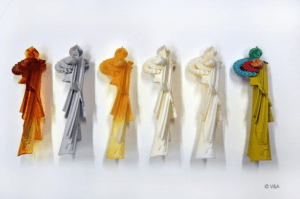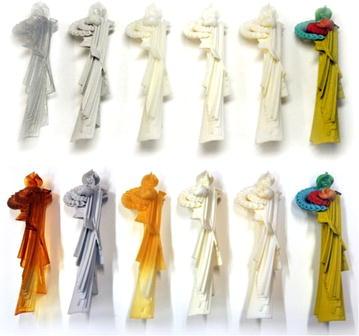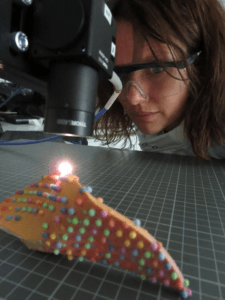 I think we can all agree that 3D printed art is a marvel, even if you’re still not sure you can technically call it art. In my personal opinion, 3D printing just takes artwork to a new level – there are so many different ways of creating art, who are we to judge if pushing a button is part of it? However, one question we need to consider as we continue to create, is if 3D printed artwork can stand the test of time. So much is known about how to conserve traditional artwork, which is normally made of more natural materials like wood and stone, but we’re still learning about the preservation of 3D printed art materials.
I think we can all agree that 3D printed art is a marvel, even if you’re still not sure you can technically call it art. In my personal opinion, 3D printing just takes artwork to a new level – there are so many different ways of creating art, who are we to judge if pushing a button is part of it? However, one question we need to consider as we continue to create, is if 3D printed artwork can stand the test of time. So much is known about how to conserve traditional artwork, which is normally made of more natural materials like wood and stone, but we’re still learning about the preservation of 3D printed art materials.
A team of University College London (UCL) scientists and researchers, from the UCL Institute for Sustainable Heritage, are working on several projects aimed at answering this question. They are partnering with engineer-turned-artist Tom Lomax for some interesting research on the subject: by creating a 3D printed piece of art that will be used for the sole purpose of scientific experimentation, so research can be done to determine how modern art can best be preserved for future generations to enjoy. Lomax has designed ‘Out of the Cauldron,’ described by UCL as “an intricate, colorful piece of digital alchemy pushing the limits of 3D printing.” It was fully 3D printed, and is freely downloadable for others.

From “Preserving Rapid Prototyping: A Review” paper: Images of the RP artwork “Out of the Cauldron” designed by Tom Lomax produced with the most common RP Technologies: (1) stereolithography (SLA) (2) polyjet (3) 3D printing (3DP) (4) selective laser sintering (SLS). Before (above) and after (below) photodegradation
The researchers subjected Lomax’s ‘Out of the Cauldron’ to accelerated testing, and throughout the process, discovered many 3D printing technologies use materials that, unfortunately, break down quite quickly. This is bad news for contemporary artists who produce their work using 3D printers and other rapid prototyping methods, at least if they want their great-great-grandchildren to be able to see their art hanging in a museum in the future. Many modern and contemporary works of art will probably not be accessible to museum patrons in a hundred years, as they degrade beyond visible hope of restoration, or at least not with the conservation methodologies currently available.
“As an artist I previously had little idea of the conservation threat facing contemporary art – preferring to leave these issues for conservators and focus on the creative process. But while working on this project with UCL I began to realise that artists themselves have a crucial role to play,” said Lomax.
NANORESTART, a project focusing on nanotechnologies and contemporary art, could help preserve millions of pieces of modern and contemporary art. It’s funded by Horizon 2020, the biggest EU Research and Innovation program ever. It will also provide a collection of data that can develop new art conservation methods, like a sunblock type of coating to help protect artwork from the hazardous effects of light degradation. Lomax’s published ‘Out of the Cauldron’ will also let researchers worldwide join in further experiments. Carolien Coon, lead researcher at the UCL Institute for Sustainable Heritage, is currently working within this project, as well as the EPSRC Center for Doctoral Training in Science and Engineering in Arts Heritage and Archaeology (SEAHA) set up by UCL, the University of Oxford, and the University of Brighton.
“Art is being transformed by fast-changing new technologies and it is therefore vital to preempt conservation issues, rather than react to them, if we are to preserve our best contemporary works for future generations,” said Coon. “This research project will benefit both artists and academics alike – but ultimately it is in the best interests of the public that art and science combine to preserve works.”
 A collaborative knowledge exchange project between leading art and design Victoria & Albert (V&A) Museum and UCL has artists and designers exploring issues related to digital art preservation. The exciting year-long “Design with Heritage” initiative, supported by the Arts and Humanities Research Council (AHRC), played a very important part in the conservation efforts for contemporary pieces of art. The project goal is to develop connections between designers, academic researchers, and arts and heritage institutions, by identifying shared interests and creating further opportunities for collaboration. One of the two project themes, ‘Design for Augmented Artefacts,’ is investigating how digital heritage is collected, preserved, and displayed, and what the possible consequences and adverse affects of this are for an authentic object in a museum.
A collaborative knowledge exchange project between leading art and design Victoria & Albert (V&A) Museum and UCL has artists and designers exploring issues related to digital art preservation. The exciting year-long “Design with Heritage” initiative, supported by the Arts and Humanities Research Council (AHRC), played a very important part in the conservation efforts for contemporary pieces of art. The project goal is to develop connections between designers, academic researchers, and arts and heritage institutions, by identifying shared interests and creating further opportunities for collaboration. One of the two project themes, ‘Design for Augmented Artefacts,’ is investigating how digital heritage is collected, preserved, and displayed, and what the possible consequences and adverse affects of this are for an authentic object in a museum.
“The Design with Heritage Project presented an excellent and rare vehicle for artists, scientists and curators to work together to explore pressing issues for the conservation and preservation of artworks made from contemporary, plastic materials,” said Boris Pretzel, Head of Science at the V&A.
Researchers with UCL have investigated the most commonly utilized technologies, in order to take on the degradation of materials in the paper ‘Preserving Rapid Prototypes: A Review.’ It was published this week in Heritage Science, and includes open access to Lomax’s artwork, so it can be downloaded and 3D printed by anyone. Discuss in the UCL forum at 3DPB.com.
[Source/Images: provided to 3DPrint.com by UCL]
Subscribe to Our Email Newsletter
Stay up-to-date on all the latest news from the 3D printing industry and receive information and offers from third party vendors.
Print Services
Upload your 3D Models and get them printed quickly and efficiently.
You May Also Like
Reinventing Reindustrialization: Why NAVWAR Project Manager Spencer Koroly Invented a Made-in-America 3D Printer
It has become virtually impossible to regularly follow additive manufacturing (AM) industry news and not stumble across the term “defense industrial base” (DIB), a concept encompassing all the many diverse...
Inside The Barnes Global Advisors’ Vision for a Stronger AM Ecosystem
As additive manufacturing (AM) continues to revolutionize the industrial landscape, Pittsburgh-based consultancy The Barnes Global Advisors (TBGA) is helping shape what that future looks like. As the largest independent AM...
Ruggedized: How USMC Innovation Officer Matt Pine Navigates 3D Printing in the Military
Disclaimer: Matt Pine’s views are not the views of the Department of Defense nor the U.S. Marine Corps Throughout this decade thus far, the military’s adoption of additive manufacturing (AM)...
U.S. Congress Calls Out 3D Printing in Proposal for Commercial Reserve Manufacturing Network
Last week, the U.S. House of Representatives’ Appropriations Committee moved the FY 2026 defense bill forward to the House floor. Included in the legislation is a $131 million proposal for...


































